The Fires of August: Tragedy on Chios
Eating Well Is The Best Revenge
“Of all the fires ablaze at this moment, I am most sickened by those on Chios, the large, historic island in the north Aegean off the coast of Turkey. The first one started at 2 a.m. on Saturday, surely a suspicious hour, as the meltemi was building up to 8 Beaufort. In the four days since then, half the island’s forests have turned to ash. But even more serious, more than 30 percent of its precious mastic groves—accounting for 50 percent of production—have been destroyed. The crystallized tears of resin, which their owners were beginning to collect, make them as flammable as matchboxes.” Diana Farr Louis
by Diana Farr Louis
ANDROS Greece—(Weekly Hubris)—9/3/2012—As I write, on the morning of August 21st, there are 283 forest fires raging throughout Greece. Our howling summer northerlies (the meltemi winds) lower temperatures but, though we welcome the relief from scorching heat waves, we have come to dread their arrival, for they are invariably accompanied by more devastating infernos.
Some fires occur through criminal negligence—a welder’s spark, a faulty power line, a cigarette—but many result from the gleam in an arsonist’s eye.
Most arsonists are never caught, but it’s the one crime I believe deserves the death penalty, for even if people and property escape undamaged, the act represents the wholesale murder of countless species and the destruction of habitats which can take decades to recover, if ever.
Of all the fires ablaze at this moment, I am most sickened by those on Chios, the large, historic island in the North Aegean off the coast of Turkey. The first one started at 2 a.m. on Saturday, surely a suspicious hour, as the meltemi was building up to 8 Beaufort. In the four days since then, half the island’s forests have turned to ash. But even more serious, more than 30 percent of Chios’s precious mastic groves—accounting for 50 percent of production—have been destroyed. The crystallized tears of resin, which their owners were just beginning to harvest, make the trees as inflammable as match boxes. The damage is currently assessed at 4 million euros, but that’s not counting the environmental and psychological costs, which can’t be measured.
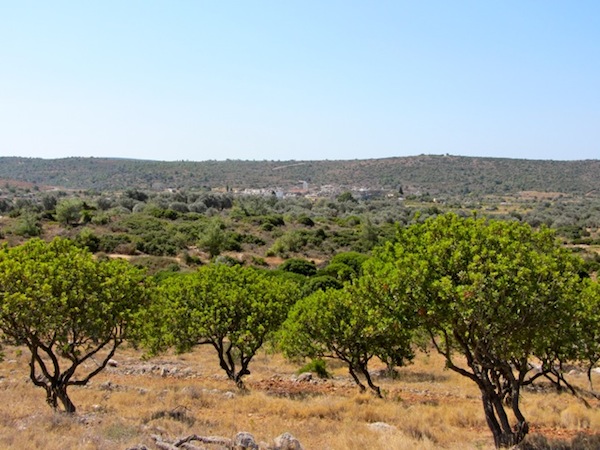
Mastic, or masticha as the Greeks call it, is especially prized as a flavoring for ice cream, breads and cakes, Turkish delight, chewing gum, and liqueurs in the Eastern Mediterranean and Arab world, where it’s also used as incense.
Mastic is nothing if not versatile. And in the last ten years two Greek companies have been vigorously promoting it to the West: the Mastihashop in food products, savory as well as sweet; and Korres in cosmetics, lotions, shampoos, and the like. At the same time, masticha liqueur has replaced limoncello as the post-prandial digestif at good restaurants.
Though some friends slot piney/musky masticha into the same category as British Marmite, “a taste that can never be acquired,” I have come to love it. (I even like Marmite!)
But I love even more the culture that developed with it, the people, villages, landscapes in southern Chios, which is where the pistacia lentiscus oozes the best quality resin in the world. Or as Chiots claim, the only true mastic.
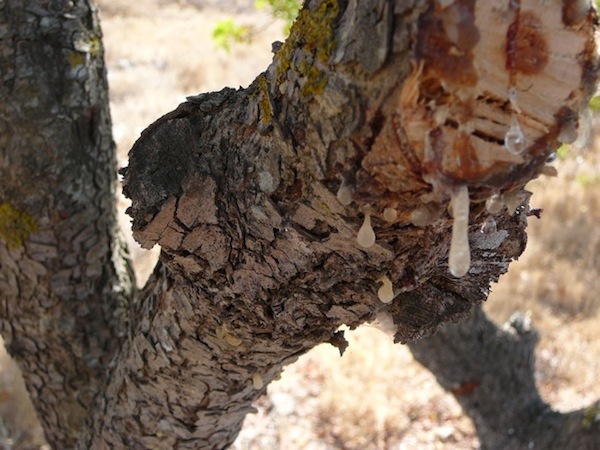
Last August, I spent several days in the mastihohoria, a collection of 24 villages, founded and walled by the Genoese 700 years ago, when they ruled Chios, to protect the growers and their crop from pirates and smugglers. These medieval treasures survived the Ottoman Occupation as the personal property of the Valide, the Sultan’s mother and, even the Massacre of 1822, when the Turks punished the islanders for wanting freedom and, presumably, their share of mastic wealth.
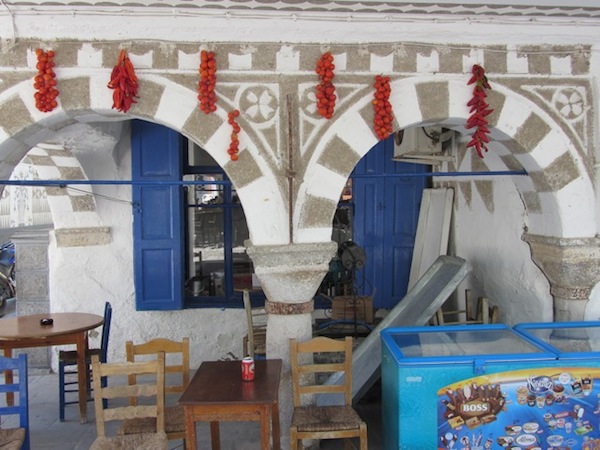
I can picture the flames licking obscenely at their walls. The news kept reporting “fronts” around Mesta, Olimbi, and Pyrgi, showing images of blackened trees etched against white ash so deep it looked like snow drifts. The meticulously tended mastic groves that stretched for miles around them, many of them a hundred years old or more, will have turned to cinders in a matter of hours.
Some 3,000 families in southern Chios live directly from their mastic trees; another 1,500 supplement their incomes by collecting mastic tears part-time. Last year, locals showed me several new groves, saying, “The crisis is sending us back to the land, to something more secure than a mere job.” But it takes at least five to six years for a tree to shed its first tear; many more for it to reach maturity and weep profusely (i.e. 5-7 ounces/100 to 200 grams).
What will they do in the meantime?
Two years ago, local cooperatives paid 76 euros or just under $100 per kilo of the crystals, so cultivating mastic is by no means easy money, but it is guaranteed. The annual crop ranges from between 80 to 150 tons.
When I asked whether young people would consider spending the long, hot hours cleaning the trees, slashing the trunks, and harvesting the sticky resin, I was told, “These trees are part of the family. We will never abandon them, and our own children will recognize their value. Don’t worry. We’ve been doing this for generations; we’re not going to stop now.”
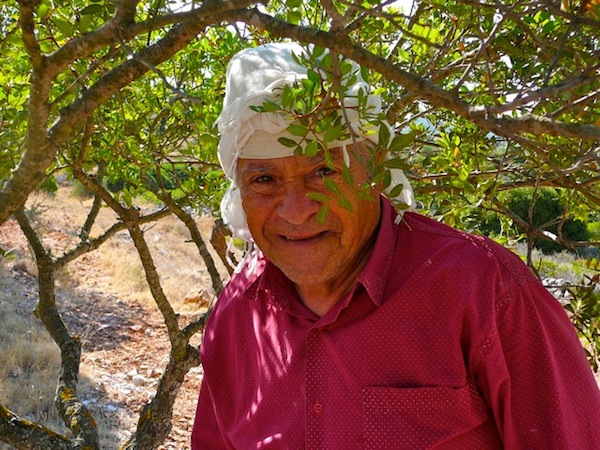
Chios, sadly, is only too familiar with disaster. Fires swept through the northern part of the island in ’79 and ’86. The fertile Kambos district never did fully recover from the earthquake of 1880, just 20 years after a surprise frost killed off its luxuriant citrus groves.
But as I wrote last year, “The best people of Chios are all connected . . . . They join forces to support each other and they’ve spun a welcoming net that embraces outsiders.”
So, if you want to help the island recover from this tragedy, buy Chios’s products (www.citrus-chios.gr has fantastic sweets); develop a taste for mastic—in the US you can buy online from www.mastihashopny.com; or pay a visit—Vassilis Ballas, my guide on Chios, runs an ecotourism agency (www.masticulture.com) from Mesta. He will introduce you to Mastic Mystique and other island treasures.
![]()
Recipe
Here’s a suggestion, not a real recipe: buy a bottle of mastiha liqueur and use it instead of white wine to add a delightful new flavor to your seafood dishes. It marries particularly well with shrimp, in pilafs or saganaki (sautéed with tomato sauce and feta). And then drink a toast to the beleaguered citizens of Chios.
PS For more on masticha, read my cover story in the latest issue of the Art of Eating (No. 89, June 2012).
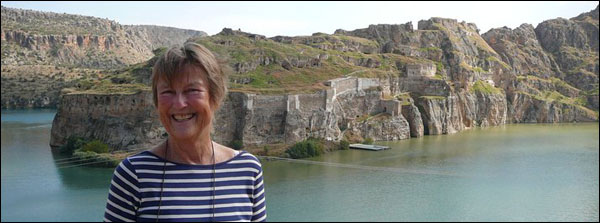

2 Comments
Eleni Kasimati
I am so sorry for this disaster. But as you said , the people of Chios know about things like that, not only from this century even from before…..
maybe they are warriors, they will built again what their tradition is.
I wish them courage and hope they won’t be alone.
Linda Makris
Chios is, I believe, the most amazing island in Greece; all the more for its mastic groves. These unique trees grow NOWHERE else on earth and we pray that the gods will help the island to recover. And to think that the fires were deliberately set is beyond belief! What horror against nature will come next? Surely, man is his own worst enemy.